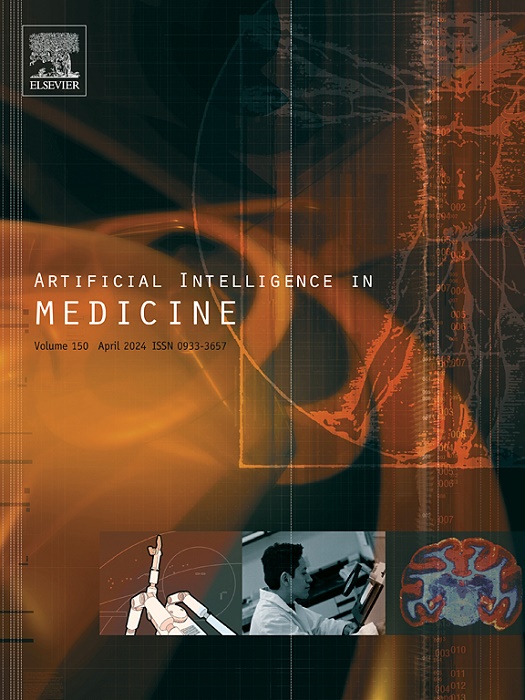基于Kolmogorov-Arnold网络的水泥粉尘暴露患者定量计算机断层成像分类
IF 6.2
2区 医学
Q1 COMPUTER SCIENCE, ARTIFICIAL INTELLIGENCE
引用次数: 0
摘要
职业健康评估对于检测由有害暴露(如水泥粉尘)引起的呼吸问题至关重要。定量计算机断层扫描(QCT)成像提供了对肺部结构和功能的详细了解,增强了肺部疾病的诊断。然而,它的高维性给传统的机器学习方法带来了挑战。方法在本研究中,使用Kolmogorov-Arnold网络(KANs)对QCT成像数据进行二元分类,以评估与水泥粉尘暴露相关的呼吸状况。该数据集包括609个人的QCT图像,其中包括311名暴露于水泥粉尘的受试者和298名健康对照者。我们得到了141个基于qct的变量,并使用了包含15个和8个神经元的两个隐藏层的KANs。网络参数,包括网格间隔、多项式顺序、学习率和惩罚强度,都经过了仔细的微调。通过各种指标评估模型的性能,包括准确性、精密度、召回率、F1评分、特异性和马修斯相关系数(MCC)。采用五重交叉验证来提高评价的稳健性。应用SHAP分析解释敏感的QCT特征。结果KAN模型的平均准确率为98.03%,精密度为97.35%,召回率为98.70%,F1评分为98.01%,特异性为97.40%。MCC值进一步证实了该模型在管理不平衡数据集方面的鲁棒性。对比分析表明,KAN模型优于传统方法和其他深度学习方法,如TabPFN、ANN、FT-Transformer、VGG19、MobileNets、ResNet101、XGBoost、SVM、随机森林和决策树。SHAP分析强调肺的结构和功能特征,如气道几何形状、壁厚和肺体积,是关键的预测因素。结论kca显著提高了QCT影像数据的分类,提高了水泥粉尘引起的呼吸系统疾病的早期发现。SHAP分析支持模型的可解释性,增强了其在职业健康评估中的临床翻译潜力。本文章由计算机程序翻译,如有差异,请以英文原文为准。
Quantitative computed tomography imaging classification of cement dust-exposed patients-based Kolmogorov-Arnold networks
Background
Occupational health assessment is critical for detecting respiratory issues caused by harmful exposures, such as cement dust. Quantitative computed tomography (QCT) imaging provides detailed insights into lung structure and function, enhancing the diagnosis of lung diseases. However, its high dimensionality poses challenges for traditional machine learning methods.
Methods
In this study, Kolmogorov-Arnold networks (KANs) were used for the binary classification of QCT imaging data to assess respiratory conditions associated with cement dust exposure. The dataset comprised QCT images from 609 individuals, including 311 subjects exposed to cement dust and 298 healthy controls. We derived 141 QCT-based variables and employed KANs with two hidden layers of 15 and 8 neurons. The network parameters, including grid intervals, polynomial order, learning rate, and penalty strengths, were carefully fine-tuned. The performance of the model was assessed through various metrics, including accuracy, precision, recall, F1 score, specificity, and the Matthews Correlation Coefficient (MCC). A five-fold cross-validation was employed to enhance the robustness of the evaluation. SHAP analysis was applied to interpret the sensitive QCT features.
Results
The KAN model demonstrated consistently high performance across all metrics, with an average accuracy of 98.03 %, precision of 97.35 %, recall of 98.70 %, F1 score of 98.01 %, and specificity of 97.40 %. The MCC value further confirmed the robustness of the model in managing imbalanced datasets. The comparative analysis demonstrated that the KAN model outperformed traditional methods and other deep learning approaches, such as TabPFN, ANN, FT-Transformer, VGG19, MobileNets, ResNet101, XGBoost, SVM, random forest, and decision tree. SHAP analysis highlighted structural and functional lung features, such as airway geometry, wall thickness, and lung volume, as key predictors.
Conclusion
KANs significantly improved the classification of QCT imaging data, enhancing early detection of cement dust-induced respiratory conditions. SHAP analysis supported model interpretability, enhancing its potential for clinical translation in occupational health assessments.
求助全文
通过发布文献求助,成功后即可免费获取论文全文。
去求助
来源期刊

Artificial Intelligence in Medicine
工程技术-工程:生物医学
CiteScore
15.00
自引率
2.70%
发文量
143
审稿时长
6.3 months
期刊介绍:
Artificial Intelligence in Medicine publishes original articles from a wide variety of interdisciplinary perspectives concerning the theory and practice of artificial intelligence (AI) in medicine, medically-oriented human biology, and health care.
Artificial intelligence in medicine may be characterized as the scientific discipline pertaining to research studies, projects, and applications that aim at supporting decision-based medical tasks through knowledge- and/or data-intensive computer-based solutions that ultimately support and improve the performance of a human care provider.
 求助内容:
求助内容: 应助结果提醒方式:
应助结果提醒方式:


